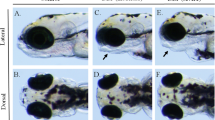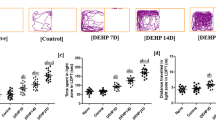Abstract
Di-butyl phthalate (DBP) is a phthalate ester (PAEs) added during the manufacturing of plastics to make them stronger, yet more pliable. DBP is noncovalently bound to plastics resulting in leaching into the environment. Concerning concentrations of DBP have been noted in surface and groundwater, aquatic ecosystems, soil and atmospheric environments globally. Global production of phthalates and thus concomitant exposure has increased over the years making studies on the ecological and environmental safety needed. Most of the literature on DBP focuses on the endocrine disrupting properties of phthalate esters, but the developmental toxicity of DBP is an understudied area. Here, we treat gastrula staged zebrafish embryos with environmentally relevant concentrations of DBP (2.5 µM). We find defects in eye development at 96 h post fertilization including a decrease in the size of the lens and retina in DBP-treated embryos. Defects in eye vascularization as well as loss of the optic nerve and optic tectum were also noted. Here we conclude that exposure to environmentally relevant doses of DBP during early embryonic development is toxic to eye development.



Similar content being viewed by others
References
Bauer MJ, Herrmann R (1997) Estimation of the environmental contamination by phthalic acid esters leaching from household wastes. Sci Total Environ 208:49–57
Benjamin S, Masai E, Kamimura N et al. (2017) Phthalates impact human health: epidemiological evidences and plausible mechanism of action. J Hazard Mater 340:360–383
Berge A, Cladiere M, Gasperi J et al. (2013) Meta-analysis of environmental contamination by phthalates. Environ Sci Pollut Res Int 20:8057–8076
Bhatia H, Kumar A, Ogino Y et al. (2014) Di-n-butyl phthalate causes estrogenic effects in adult male Murray rainbowfish (Melanotaenia fluviatilis). Aquat Toxicol 149:103–115
Bissegger S, Pineda Castro MA, Yargeau V et al. (2018) Phthalates modulate steroid 5-reductase transcripts in the western clawed frog embryo. Comp Biochem Physiol C Toxicol Pharmacol 213:39–46
Chen H, Feng W, Chen K et al. (2019a) Transcriptomic analysis reveals potential mechanisms of toxicity in a combined exposure to dibutyl phthalate and diisobutyl phthalate in zebrafish (Danio rerio) ovary. Aquat Toxicol 216:105290
Chen H, Feng W, Chen K et al. (2021) Transcriptomic responses predict the toxic effect of parental co-exposure to dibutyl phthalate and diisobutyl phthalate on the early development of zebrafish offspring. Aquat Toxicol 235:105838
Chen H, Mao W, Shen Y et al. (2019b) Distribution, source, and environmental risk assessment of phthalate esters (PAEs) in water, suspended particulate matter, and sediment of a typical Yangtze River Delta City, China. Environ Sci Pollut Res Int 26:24609–24619
Chen X, Xu S, Tan T et al. (2014) Toxicity and estrogenic endocrine disrupting activity of phthalates and their mixtures. Int J Environ Res Public Health 11:3156–3168
Cheng Z, Nie XP, Wang HS et al. (2013) Risk assessments of human exposure to bioaccessible phthalate esters through market fish consumption. Environ Int 57-58:75–80
Chu PC, Wu C, Su TC (2021) Association between urinary phthalate metabolites and markers of endothelial dysfunction in adolescents and young adults. Toxics 9:33
Dai YJJY, Chen N, Bian WP, Li QK, Ma YB, Chen YL, Pei DS (2014) Zebrafish as a model system to study toxicology. Environ Toxicol Chem 33:11–17
Dong X, Qiu X, Meng S et al. (2018) Proteomic profile and toxicity pathway analysis in zebrafish embryos exposed to bisphenol A and di-n-butyl phthalate at environmentally relevant levels. Chemosphere 193:313–320
Fairbairn EA, Bonthius J, Cherr GN (2012) Polycyclic aromatic hydrocarbons and dibutyl phthalate disrupt dorsal-ventral axis determination via the Wnt/beta-catenin signaling pathway in zebrafish embryos. Aquat Toxicol 124-125:188–196
Gardner ST, Wood AT, Lester R et al. (2016) Assessing differences in toxicity and teratogenicity of three phthalates, diethyl phthalate, di-n-propyl phthalate, and di-n-butyl phthalate, using Xenopus laevis embryos. J Toxicol Environ Health A 79:71–82
Hannas BR, Lambright CS, Furr J et al. (2012) Genomic biomarkers of phthalate-induced male reproductive developmental toxicity: a targeted RT-PCR array approach for defining relative potency. Toxicol Sci 125:544–557
Howdeshell KL, Wilson VS, Furr J et al. (2008) A mixture of five phthalate esters inhibits fetal testicular testosterone production in the sprague-dawley rat in a cumulative, dose-additive manner. Toxicol Sci 105:153–165
Hu X, Gu Y, Huang W et al. (2016) Phthalate monoesters as markers of phthalate contamination in wild marine organisms. Environ Pollut 218:410–418
Huang PC, Tien CJ, Sun YM et al. (2008) Occurrence of phthalates in sediment and biota: relationship to aquatic factors and the biota-sediment accumulation factor. Chemosphere 73:539–544
Jergensen T, Cusmano D, Roy NM (2019) Di-butyl phthalate (DBP) induces craniofacial defects during embryonic development in zebrafish. Ecotoxicology 28:995–1002
Jiao Y, Tao Y, Yang Y et al. (2020) Monobutyl phthalate (MBP) can dysregulate the antioxidant system and induce apoptosis of zebrafish liver. Environ Pollut 257:113517
Johns LE, Cooper GS, Galizia A et al. (2015) Exposure assessment issues in epidemiology studies of phthalates. Environ Int 85:27–39
Kay VR, Bloom MS, Foster WG (2014) Reproductive and developmental effects of phthalate diesters in males. Crit Rev Toxicol 44:467–498
Kimmel CB, Ballard WW, Kimmel SR et al. (1995) Stages of embryonic development of the zebrafish. Dev Dyn 203:253–310
Kohn MC, Parham F, Masten SA et al. (2000) Human exposure estimates for phthalates. Environ Health Perspect 108:A440–A442
Latini G, Del Vecchio A, Massaro M et al. (2006) Phthalate exposure and male infertility. Toxicology 226:90–98
Lawson ND, Weinstein BM (2002) In vivo imaging of embryonic vascular development using transgenic zebrafish. Dev Biol 248:307–318
Lee SK, Veeramachaneni DN (2005) Subchronic exposure to low concentrations of di-n-butyl phthalate disrupts spermatogenesis in Xenopus laevis frogs. Toxicol Sci 84:394–407
Lee YM, Lee JE, Choe W et al. (2019) Distribution of phthalate esters in air, water, sediments, and fish in the Asan Lake of Korea. Environ Int 126:635–643
Liang DW, Zhang T, Fang HH et al. (2008) Phthalates biodegradation in the environment. Appl Microbiol Biotechnol 80:183–198
Lu C, Luo J, Liu Y et al. (2021) The oxidative stress responses caused by phthalate acid esters increases mRNA abundance of base excision repair (BER) genes in vivo and in vitro. Ecotoxicol Environ Saf 208:111525
Mahaboob Basha P, Radha MJ (2017) Gestational di-n-butyl phthalate exposure induced developmental and teratogenic anomalies in rats: a multigenerational assessment. Environ Sci Pollut Res Int 24:4537–4551
Mu X, Huang Y, Li J et al. (2018) New insights into the mechanism of phthalate-induced developmental effects. Environ Pollut 241:674–683
Oehlmann J, Oetken M, Schulte-Oehlmann U (2008) A critical evaluation of the environmental risk assessment for plasticizers in the freshwater environment in Europe, with special emphasis on bisphenol A and endocrine disruption. Environ Res 108:140–149
Ohtani H, Miura I, Ichikawa Y (2000) Effects of dibutyl phthalate as an environmental endocrine disruptor on gonadal sex differentiation of genetic males of the frog Rana rugosa. Environ Health Perspect 108:1189–1193
Pu SY, Hamid N, Ren YW et al. (2020) Effects of phthalate acid esters on zebrafish larvae: development and skeletal morphogenesis. Chemosphere 246:125808
Qian L, Liu J, Lin Z et al. (2020) Evaluation of the spinal effects of phthalates in a zebrafish embryo assay. Chemosphere 249:126144
Rodrigues K, Batista-Silva H, Sousa de Moura KR et al. (2020) Dibutyl phthalate rapidly alters calcium homeostasis in the gills of Danio rerio. Chemosphere 258:127408
Schecter A, Lorber M, Guo Y et al. (2013) Phthalate concentrations and dietary exposure from food purchased in New York State. Environ Health Perspect 121:473–494
Schettler T (2006) Human exposure to phthalates via consumer products. Int J Androl 29:134–139. discussion 181–135
Staples CA, Peterson DR, Parkerton TF, Adams WJ (1997) The environmental fate of phthalate esters: a literature review. Chemosphere 35:667–749
Sun G, Li Y (2019) Exposure to DBP induces the toxicity in early development and adverse effects on cardiac development in zebrafish (Danio rerio). Chemosphere 218:76–82
Sun J, Wu X, Gan J (2015) Uptake and metabolism of phthalate esters by edible plants. Environ Sci Technol 49:8471–8478
Tanguay RL (2018) The rise of zebrafish as a model for toxicology. Toxicol Sci 163:3–4
Tao Y, Yang Y, Jiao Y et al. (2020) Monobutyl phthalate (MBP) induces energy metabolism disturbances in the gills of adult zebrafish (Danio rerio). Environ Pollut 266:115288
Westerfield M (2000) The zebrafish book. A guide for the laboratory use of zebrafish (Danio rerio), 4th edn. University of Oregon Press, Eugene, OR
Wofford HW, Wilsey CD, Neff GS et al. (1981) Bioaccumulation and metabolism of phthalate esters by oysters, brown shrimp, and sheepshead minnows. Ecotoxicol Environ Saf 5:202–210
Wojtowicz AK, Szychowski KA, Wnuk A et al. (2017) Dibutyl phthalate (DBP)-induced apoptosis and neurotoxicity are mediated via the aryl hydrocarbon receptor (AhR) but not by estrogen receptor alpha (ERalpha), estrogen receptor beta (ERbeta), or peroxisome proliferator-activated receptor gamma (PPARgamma) in mouse cortical neurons. Neurotox Res 31:77–89
Xu H, Dong X, Zhang Z et al. (2015) Assessment of immunotoxicity of dibutyl phthalate using live zebrafish embryos. Fish Shellfish Immunol 45:286–292
Xu H, Shao X, Zhang Z et al. (2013) Oxidative stress and immune related gene expression following exposure to di-n-butyl phthalate and diethyl phthalate in zebrafish embryos. Ecotoxicol Environ Saf 93:39–44
Xu N, Chen P, Liu L et al. (2014) Effects of combined exposure to 17alpha-ethynylestradiol and dibutyl phthalate on the growth and reproduction of adult male zebrafish (Danio rerio). Ecotoxicol Environ Saf 107:61–70
Zheng X, Zhang BT, Teng Y (2014) Distribution of phthalate acid esters in lakes of Beijing and its relationship with anthropogenic activities. Sci Total Environ 476-477:107–113
Acknowledgements
The Lawson Lab (University of Massachusetts Medical Center) kindly provided the Tg(fli1:EGFP) transgenic line. The Tg(pou4f3:GAP-GFP)^s356tTg transgenic line was purchased through Zebrafish International Resource Center (ZIRC), University of Oregon.
Funding
This research was supported by Sacred Heart University.
Author information
Authors and Affiliations
Contributions
All authors contributed to the study conception and design. Material preparation, data collection and analysis were performed Sophie Barbagallo, Cassidy Baldauf, Emily Orosco and Nicole M. Roy. The first draft of the manuscript was written by Nicole M. Roy and all authors commented on previous versions of the manuscript. All authors approved the final manuscript.
Corresponding author
Ethics declarations
Conflict of interest
The authors declare no competing interests.
Ethical approval
All applicable international, national and/or institutional guidelines for the care and use of animals were followed. This article does not contain any studies with human participants performed by any of the authors. The treatments and protocols were approved by the Sacred Heart University Institutional Animal Care and Use Committee as meeting ethical standard for scientific research.
Additional information
Publisher’s note Springer Nature remains neutral with regard to jurisdictional claims in published maps and institutional affiliations.
Rights and permissions
About this article
Cite this article
Barbagallo, S., Baldauf, C., Orosco, E. et al. Di-butyl phthalate (DBP) induces defects during embryonic eye development in zebrafish. Ecotoxicology 31, 178–185 (2022). https://doi.org/10.1007/s10646-021-02468-5
Accepted:
Published:
Issue Date:
DOI: https://doi.org/10.1007/s10646-021-02468-5




